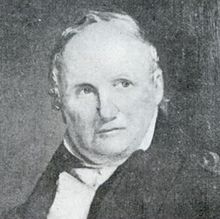Samuel Dinsmoor
Samuel Dinsmoor (born July 1, 1766 in Windham , Rockingham County , New Hampshire Colony , † March 15, 1835 in Keene , New Hampshire ) was an American politician and governor of the state of New Hampshire from 1831 to 1835 . He represented his state from 1811 to 1813 as a member of Congress .
Early years and political advancement
Samuel Dinsmoor attended Dartmouth College until 1789 . He then worked for some time as a teacher before continuing his education with a law degree. After his exams and his admission as a lawyer in 1795, he worked in Keene in his new profession. There he was also involved in setting up an infantry unit for the local militia, of which he became the commander. In 1808 he also became a postman in this town.
Between March 4, 1811 and March 3, 1813 he was a member of the United States House of Representatives . Dinsmoor was then a member of the Democratic Republican Party . After its dissolution, he joined President Andrew Jackson's Democratic Party in the late 1820s . In 1820 he was one of James Monroe's electors . Between 1823 and 1831 he was a probate judge in Cheshire County . He was also a member of a delegation in 1825 to settle a border dispute with the neighboring state of Massachusetts .
New Hampshire Governor
In 1831 Dinsmoor was elected as the new governor of his state. After being re-elected twice, he was able to exercise this office between June 2, 1831 and June 5, 1834. During his tenure, New Hampshire experienced an economic boom. Production rose and the banks flourished. At that time, the railroad construction in New Hampshire was promoted. The first free library in the United States was built in Peterborough . Some of the governor's proposals, such as the establishment of a state mental hospital, could not be politically implemented at the time.
Another résumé
After the end of his governorship, Dinsmoor withdrew from politics. He became President of Ashuelot Bank in Keene. Samuel Dinsmoor died just nine months after the end of his political career on March 15, 1835. With his wife Mary Boyd Reid he had four children, including the son Samuel Dinsmoor Jr. (1799-1869), who was also governor of 1849-1851 New Hampshire should be.
Web links
- Samuel Dinsmoor in the National Governors Association (English)
- Biography of New Hampshire (English)
- Samuel Dinsmoor in the Biographical Directory of the United States Congress (English)
- Samuel Dinsmoor in the database of Find a Grave (English)
| personal data | |
|---|---|
| SURNAME | Dinsmoor, Samuel |
| BRIEF DESCRIPTION | American politician |
| DATE OF BIRTH | July 1, 1766 |
| PLACE OF BIRTH | Windham , New Hampshire |
| DATE OF DEATH | March 15, 1835 |
| Place of death | Keene , New Hampshire |


